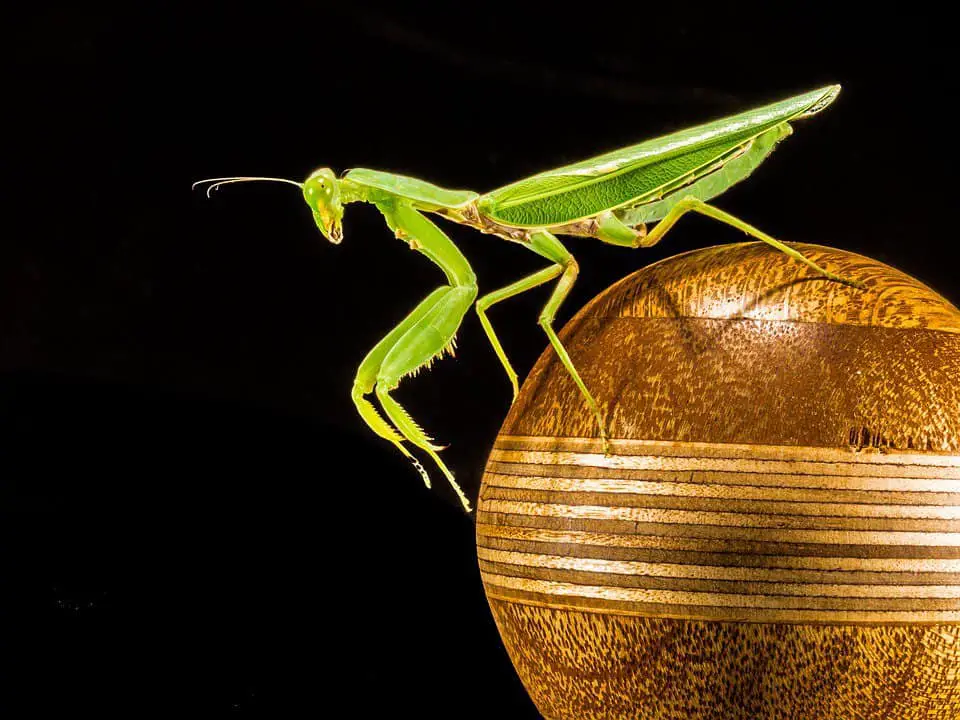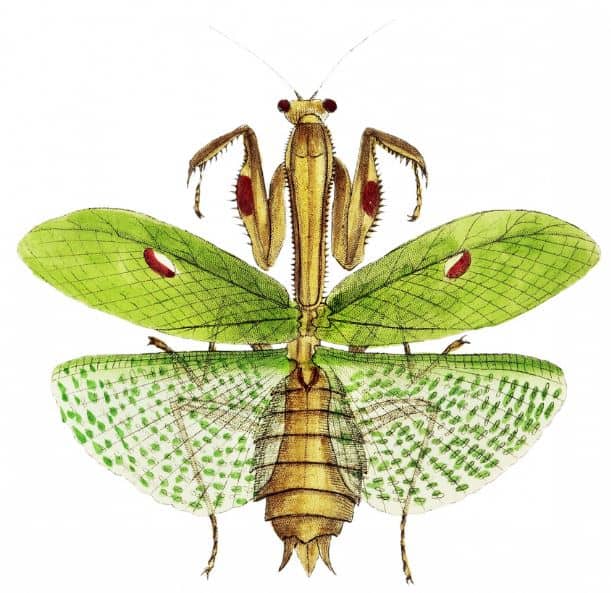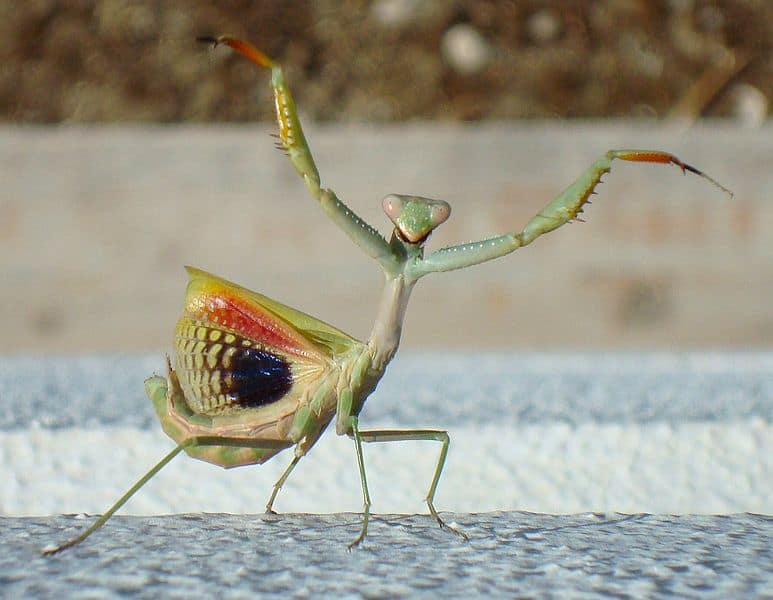The praying mantis is a beautiful insect that left a trail in our culture. From children’s movies to historical references, the praying mantis has an important place in our world thanks to its unique traits and amazing tools.
It has the eyes, reflexes, and razor-like front legs to battle larger predators and come out ahead, making it such a fantastic fighter that it inspired a famous fighting style.
The praying mantis is sitting at a privileged place in our minds because it deserves to. However, even though we may know plenty of things about this exotic insect, most people still get confused about whether it can fly or not.
Does the praying mantis have wings to fly? Considering their wide variety of tools, is flying too much to ask from them? Can all 1,800 praying mantis species fly? These questions can’t be answered by yes or no, so we’ll take a deep dive into this topic and teach you everything you need to know about mantid’s flight.
When people talk about the “praying” mantis they usually mean the Mantis Religiosa, or European Mantis. This species is Macropterous and thus capable of flight. However, many other mantid species can not fly. Keep reading to learn more.

Types of Praying Mantis
To understand the praying mantis’ capacity for flight, first, we need to take a quick look at the different types of mantis. Some types can fly, while others cannot.
There are two ways to classify praying mantids: their appearance and their wings. As you’d probably have guessed by now, organizing the praying mantis according to its appearance isn’t relevant to the topic at hand. However, knowing the types of mantis according to their wings changes everything about their flight capacity. These types of praying mantis are macropterous, brachypterous, micropterous, or apterous.
Apterous
Apterous mantids are those species that don’t develop wings at any point in their lives. This small group of mantids is entirely unable to fly, and they have no wings to use for self-defense either.
Micropterous
Mantids in this category have wings, but they might as well prescind of them since they’re useless. A micropterous praying mantis has remnants of what may have been wings at an earlier evolutionary stage. Other than sometimes providing an interesting visual detail, these wings can’t be used for flying or anything else.
Brachypterous
A brachypterous praying mantis has wings that can often be used for flying, but their wings are still on the short side.
Mantids under this classification aren’t good at flying, but most of them are at least able to fly a little bit.
However, some of the larger female mantids won’t ever be able to take flight due to their short wings and heavy weight. These wings will, however, be useful for self-defense purposes, as will be covered later in this article.
Macropterous

The macropterous praying mantids are those with long wings that enable them to fly. The majority of praying mantis species fall into this category, so most of them will have the capacity to fly.
Male and female mantids in this category can always fly; however, as we’ll see in the next segment, not all of them will be great at it.
Macropterous mantids can also perfectly use their wings in self-defense, so they’re useful even on firm ground.
Male and Female Mantids
The praying mantis, as a family of species, exhibits something called sexual dimorphism. This means that male and female members of the same species are different, so it’s possible to tell the difference between them just by looking at them.
A couple of the most significant differences between male and female mantids affect their flight capacity directly: their size and the length of their wings.
Male mantids have longer wings and smaller bodies, allowing them to fly quickly and efficiently. They also have a larger set of antennae in their heads, meaning that their navigation senses are better, providing them with an advantage during flights.
Female mantids on the other side are larger and heavier, with shorter wings and smaller antennae. They have the best chance of surviving a fight with bigger predators, but when it comes to flying, they’re not as good as their male counterparts. This makes them a bigger target to predators in the air since they’re slow and bulky.
These differences affect their behavior, so male mantids are prone to flying while female mantids are more inclined to stay and fight. This means that if you’ve only seen female mantids in your life, chances are that you’ve never seen them flying. That’s one of the biggest reasons why people are confused about the praying mantis’ capacity to fly. Some of them are unable to, while others prefer to avoid it as much as possible.
There’s More to Wings than Flying

We’ve established that the praying mantis is mostly able to use its wings to fly. However, as was hinted in this article, mantids don’t limit their use of wings to flying; they also use them for self-defense.
The praying mantis has a known self-defense tactic that it uses to distract or scare predators. It’s a posture where they spread their body as wide as possible to look bigger, using their front legs and spreading their wings to create the illusion that they’re a much bigger creature than they actually are.
This is called the threat posture, and some praying mantids, such as the Indian Flower Mantis, actually have eye-like shapes in their eyes to make this illusion more realistic.
Male praying mantids will use this tactic to distract their predators, looking for a chance to fly away and escape.
On the contrary, female mantids use this to scare bigger predators away and assert dominance over their territory. A female will also use it to confuse them while looking for the best chance to attack. It’s an effective self-defense and survival mechanism and relies on the wings to create the full effect.
Final words
So, there you have it. Most mantis species can indeed fly, but not all of them. It all depends on what type of mantis they are. The macropterous and brachypterous species can indeed fly, but the apterous and micropterous species are incapable of flight.
Nevertheless, whether it’s able to fly or not, the praying mantis is an incredible pet that you should consider adding to your collection. It’s easy to care for, beautiful, and very interesting to look at.
Hobbyists don’t miss the chance to take great pictures of them when using a threat posture, considering that some of them have mesmerizing patterns on their wings that are worthy of looking at.
- How Long Do American Eskimo Dogs Live? Important Factors and Care Tips - September 29, 2023
- Do American Bulldogs Need Grooming? Essential Tips and Care Guidelines - September 29, 2023
- Do Bengal Cats Enjoy Playing? Essential Tips for Keeping Them Active - September 29, 2023